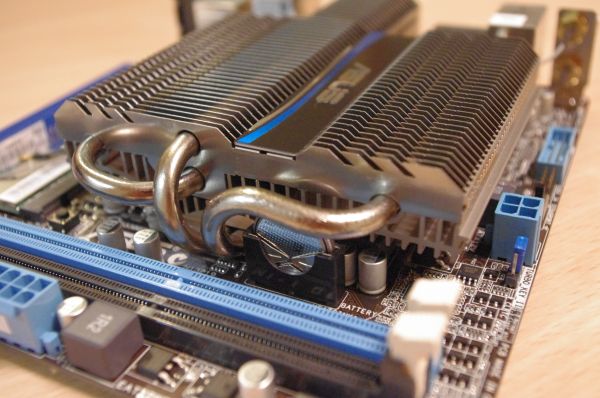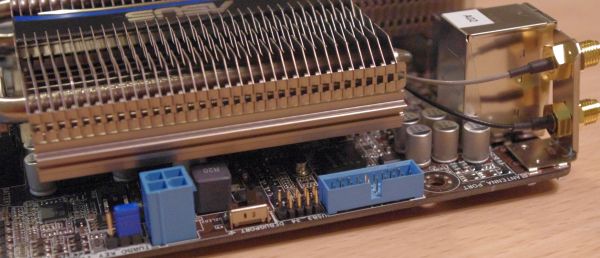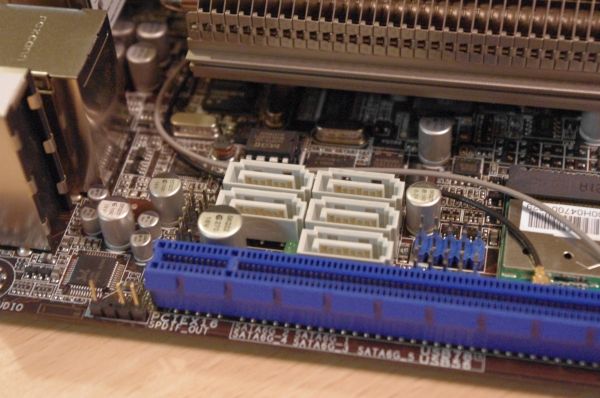Fusion E-350 Review: ASUS E35M1-I Deluxe, ECS HDC-I and Zotac FUSION350-A-E
by Ian Cutress on July 14, 2011 11:00 AM ESTEver since I first tinkered around with the ASUS board, I had a love/hate relationship with it. It's a prime example of what a lot of people may want in a board - it's passive, the wifi is already built in (you just fix the antenna), and it runs straight out of the box. But the more I prodded around the vibrant exterior, I tried to find what I would get for my $175, especially compared to the other boards I have here for review.
Despite the E-350 processor on board, the passive heatsink gets incredibly hot to touch, even at idle in a fanless environment. The CPU itself is rated at 18W, and without a discrete GPU, the board is pulling around 60W in our stringent tests. This is disconcerting, considering that the ECS board (even though it isn't passive) pulls off a 33% overclock. Also, due to the size passive heatsink, the IO panel is hit - the onboard audio has only two outputs and we're limited to DVI and HDMI video. This doesn't happen on the Zotac board, which is also passive.
Visual Inspection
I've mentioned it before and I'll mention it again - heatsink. This motherboard has a massive one, with ASUS on it, just in case you forgot. The heatsink is still shorter than any full height DDR3 memory you put in the DIMM slots, and there are two fan headers found in the top left, just beside the heatsink in that corner.
There is a USB 3.0 header along the top of the board, along with a debug header, a Turbo switch, a 4-pin 12 V CPU connector and the Clear CMOS header. Unfortunately, the writing next to these is all mixed up - the writing above the turbo switch says 'DEBUG PORT' and above the Clear CMOS is 'TURBO_KEY+II'. Nowhere on the board does it say the Clear CMOS is the Clear CMOS - during bad overclocking I had to refer to the manual to find this information.
Thankfully, the front panel connectors are still on the right hand side of the DDR3 DIMM slots (unlike the ECS), and the wifi card is preinstalled in a very tight space the other side of the DIMMs. The five SATA 6 Gbps ports are also here, with USB 2.0 headers, and the MEM OK button which is ASUS' memory adaptation feature if there is incompatibility with any memory module changes. The HD Audio header is on the far left of these headers and ports, which could cause an issue depending on where the cable is coming from and what's installed on the board. There is also a full length PCIe slot - it will accept any 16x peripheral, but run it at 4x speeds, including discrete GPUs.
The I/O panel is a mixture of positive and negative. Because of the large heatsink impinging into the panel, some of the functionality is lost. Alongside the two antenna ports, we have a single PS/2 port, four USB 2.0 ports, two USB 3.0 ports, HDMI (1.3b) and DVI video outputs, optical S/PDIF Out, a Bluetooth receiver, an eSATA 6 Gbps port, an Ethernet port and three audio jacks. The big surprise here is that the HDMI is only 1.3b and not 1.4a...




















67 Comments
View All Comments
Anato - Saturday, July 16, 2011 - link
I'm worried about Anandtechs reputation and objectivity of AMD reviews. As a reader I can say from the text when the article is about AMD even if I hide all the product names and technical words. The wording is different and the questions put up are doubtful. Also focus is put to things where product is not intended to.Then there is benchmarks where always there is this "magical" Intel on top of the chars, but no word about the setup (mb, cpu, memory) costing 3 times more. Words from Atom review: "When the Atom first appeared I immediately did my best to characterize its performance."
Next big thing is that there is no Atom on the chars, why? No wonder Core i5 2500K beats up the E-350, but why is it not put to power chars?
PSU, if you don't have the gear to test then don't publish misleading results instead. Never have seen this happen on Intel, like "We only had one DDR3 Dimm"
Last two points go to GF 580? Who would put this to Atom/E-350 board? And again no Atom around "holding GPU back".
I really appreciate what you are doing in SSD-front and many other areas but for me this review isn't right.
duploxxx - Thursday, July 14, 2011 - link
Official Hudson D3 TDP = 7.8W, doesn't mean it actually draws that much power.so pls change power draw to TDP....
Spivonious - Thursday, July 14, 2011 - link
The first one looks like it has great potential for an HTPC build. Stick it in an ITX case with a fan to exhaust the hot air and you have a quiet, powerful, and small HTPC.SanLouBlues - Thursday, July 14, 2011 - link
The DirectX 11 patch for Crysis 2 is out now.Vepsa - Thursday, July 14, 2011 - link
I'm considering a Hudson board for my home server (probably the ECS one to be honest) and I'm wondering if the SATA/eSATA ports support port multiplier technology. If they do, the would be just about perfect for me.yeeeeman - Thursday, July 14, 2011 - link
Until I have seen two or three reviews on the Internet who don't try to give a wrong impression about the power consumption of an AMD system based on E-350.Even myself, and I'm not a pro in this domain I have a 200W power supply who gets much better results than the you've used.ckryan - Thursday, July 14, 2011 - link
I love the ITX form factor. I love it's limitations. I love the necessity of axing the dead weight -- no PATA, no PCI, ect. Graphical UEFIs are great, and I'm ready to do away with the trusty old BIOS. So there isn't much to get in the way of, even if the E-350 isn't the hottest of the new hotness. Thanks, Ian, for an excellent round up. It's easy for motherboard reviews to get lost in the shuffle, and this roundup is worth the read.onlineaddy - Thursday, July 14, 2011 - link
So, what's the author's conclusion/recommendation? Is any one of the three worth our hard-earned $?Rick83 - Thursday, July 14, 2011 - link
First of all: 100Mb LAN test was a waste of time/space, especially the graphic.A Gbit LAN test on the other hand might have been interesting, as these small computers can be used as thin clients, relying heavily on low latency and high troughput.
Also, the processor time graphic should have been for Gbit LAN, as pushing 8MB/s over a line is not nearly as taxing as doing the same for 80 MB/s (buffering a movie off remote storage, loading a user profile during log-in, etc)
The performance graphs seemed to me to be an excercise of futilty, dedicated to measuring noise. Three identical chipsets and three identical cpus would not diverge beyond noise in the clock generator.
The conclusion is also way too performance oriented.
The Zotac isn't bad because its performance is middling or because it lacks overclocking. As a passive design, overclocking can be safely ignored anyway, and a socket 1156 board can be gotten in miniITX size that will blow this out of the water, at a similar cost.
What is wrong with the Zotac, is that there are plenty of issues, that have arisen during testing.
Not as bad as an unstable UEFI image, but the lower than average usb-performance, the latency spikes - those can be really annoying.
And, frankly, the ECS, including VGA? That's a bit archaic...
I think performance for platforms that are not performance oriented is not really the most important point, even if that's what you're used to.
In general, for mainboards performance isn't the most important factor. Build quality, stability, software and features are far more important, as is the quality of the onboard non-PCH hardware, like sound quality, WLAN performance, LAN performance, quality of the VGA outputs, memory compatibility and many other things that sadly don't get covered in main board reviews.
I'd be glad if more relevant (perhaps only to me) factors for purchase decisions were to feature in future reviews.
And please test that ASUS Gene-Z soon, pretty please?
IanCutress - Thursday, July 14, 2011 - link
Hi Rick,I'm always open to comments or alternative tests that could be run - updating the test suite is always in motion as and when what is required. Bare in mind that as we're individual reviewers at AT, we don't all have access to the appropriate gear for testing right away. If you've got any suggestions, you can email me from my name at the top of the review.
All the best,
Ian